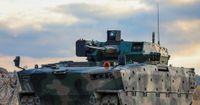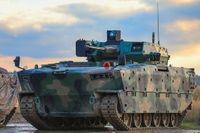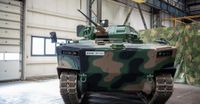On March 27, 2025, a significant step was taken in the modernization of the Polish Army as the Ministry of National Defense (MON) signed a contract worth approximately 6.57 billion PLN for the procurement of 111 Borsuk infantry fighting vehicles (IFVs). This agreement marks a pivotal moment in the transition from outdated Soviet-era BWP-1 vehicles to a new generation of combat vehicles designed to meet contemporary military needs.
The signing ceremony took place at 11:00 AM at the Military Center for Civic Education in Warsaw, attended by key officials including Deputy Prime Minister and Minister of Defense Władysław Kosiniak-Kamysz, Minister of State Assets Jakub Jaworowski, and Minister of Interior and Administration Tomasz Siemoniak. The contract includes a comprehensive training and logistics package, with deliveries scheduled from 2025 to 2029.
The Borsuk IFV is based on the Universal Modular Tracked Platform (UMPG) and is equipped with a remotely controlled turret system known as ZSSW-30. The vehicle is designed to transport six soldiers alongside a crew of three, which includes a commander, a weapon operator, and a driver. It boasts impressive specifications, measuring 7.6 meters in length, 3.4 meters in width, and 3.34 meters in height, with a combat weight of 28,000 kg.
One of the standout features of the Borsuk is its ability to swim while maintaining a high level of ballistic protection. The vehicle's armor meets STANAG 4569 level 5 standards at the front and level 3 on the sides, providing robust protection against various threats, including anti-tank weapons and improvised explosive devices. This capability sets the Borsuk apart from competitors like the Swedish CV90 and the German Lynx.
During the signing ceremony, Kosiniak-Kamysz emphasized the importance of increasing production capacities to meet the growing demand for modern armored vehicles. "I know there is significant interest; I would like production capacities to be as high as possible. This is the challenge we face today, as we want to order more. 111 is just the beginning," he stated.
The Borsuk program is a result of a framework agreement signed on February 28, 2023, which outlines the acquisition of approximately 1,400 Borsuk vehicles for 17 line battalions and training units, along with around 350 specialized vehicles based on the UMPG platform. The first models of the Borsuk are expected to roll off the production line later this year, with the final units entering service by 2029.
The development of the Borsuk began in 2013 when the National Center for Research and Development (NCBiR) announced a competition to create a prototype for a new floating infantry fighting vehicle. A consortium led by Huta Stalowa Wola won the contract in 2014, and the first public demonstration of the Borsuk took place at the MSPO trade fair in 2017.
Despite facing numerous challenges during its development, including the need to balance buoyancy with ballistic protection, the Borsuk has emerged as a technological marvel. The vehicle features the ZSSW-30 turret, which is equipped with a 30 mm Mk 44S Bushmaster automatic cannon capable of firing programmable ammunition, enhancing its effectiveness against various targets.
The Borsuk's armament also includes a 7.62 mm UKM-2000 machine gun and a double launcher for Spike-LR anti-tank guided missiles, providing it with the versatility to engage infantry, armored vehicles, and aerial threats in all weather conditions.
In total, the Borsuk program aims to deliver around 1,400 units, including specialized variants such as the Żuk tracked reconnaissance carriers, Oset command vehicles, Gotem medical evacuation vehicles, and Gekon technical security vehicles. This comprehensive approach to vehicle development represents a significant leap forward for the Polish military.
However, questions remain regarding the scale of the initial order. Critics have pointed out that the demand for modern infantry fighting vehicles in the Polish Army could reach between 1,500 and 2,000 units, especially with plans to increase the army's size. Concerns about production capabilities and funding have been raised, with Kosiniak-Kamysz acknowledging these challenges during the contract signing.
"I know that there is a significant interest; I would like production capacities to be as high as possible. This is the challenge we face today, as we want to order more. 111 is just the beginning," he reiterated.
The Borsuk's development is not just about creating a new vehicle; it symbolizes the revival of Poland's defense industry. By designing and producing this advanced combat vehicle, Polish engineers and manufacturers are demonstrating their capabilities in modern military technology.
As the Polish Army prepares to retire its aging BWP-1 vehicles, the Borsuk represents a new era of mechanized warfare for Poland. With its advanced features and robust design, it is expected to significantly enhance the operational capabilities of the Polish armed forces, ensuring that soldiers have access to equipment that meets the highest standards of contemporary battlefield requirements.
The future of the Borsuk program looks promising, with potential for further contracts to expand the fleet. As the Polish military moves forward, the Borsuk is set to play a crucial role in shaping the future of its mechanized forces.








